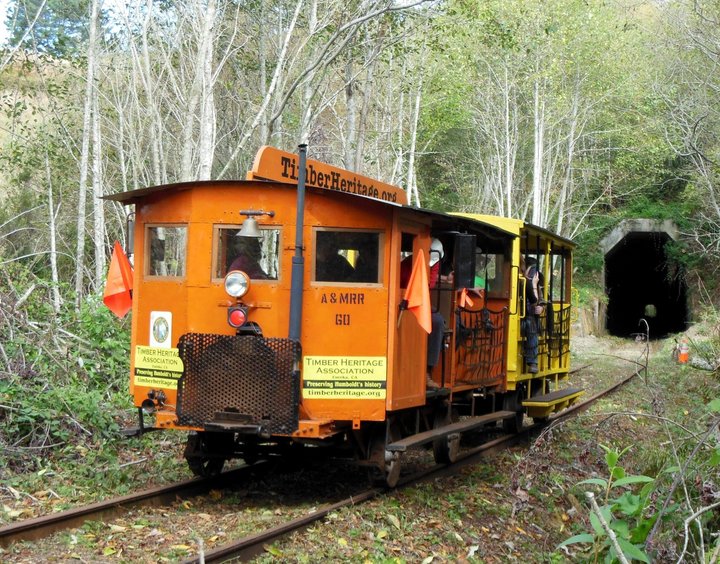I published a book a few weeks back, The Humbook, shamelessly promoting it right here. I figured if the great Chron columnist Jon Carroll could write — regularly, repeatedly! — about his cat Pancho, I could be allowed to indulge in a tad of self-hype. (Carroll’s last column appeared in 2015, after 33 years on the job.) [And never sold his cat. —Ed.]
Where was I? Oh yes, my book. I’ve been fielding questions about the contents, including those dealing with one of my favorite local subjects, the Loleta Tunnel. It’s such a good story — I’ve written about it elsewhere — it bears retelling. Not to mention, it makes for a fun afternoon excursion, walking the mile up from Loleta town to the southwest tunnel portal, then a third of a mile through the tunnel. It’s still in pretty good shape, especially after the major renovation in 1960, which included an extension of the southwest portal. Tracks still run through it, although the Timber Heritage Association’s speeder, which (in “normal” summers) occasionally runs up from Loleta, stops short of actually entering the tunnel.

Timber Heritage Association’s speeder near the southwest portal. (Mike Kellogg, used with permission)
It was originally built to allow the Pacific Lumber Company, which owned huge tracts of redwood in the Eel valley, to bring logs to their huge new Scotia mill. Previous attempts at circumnavigating the ridge (anticline) under which the tunnel runs had been unsuccessful. The most ambitious of these was a five-mile-long mule-powered, wooden-track railroad that ran around the western end of Table Bluff, from McNulty Slough to the then-new settlement of Southport Landing, a couple of miles southwest of Fields Landing (below the present-day Wiyot reservation). Built in 1873, the wooden railroad barely survived for five years, and a huge storm in the winter of 1878 permanently wrecked it.
Soon after, several lumber barons, including William Carson (Carson’s Mansion) and Captain Henry Buhne (boo-ner) (Eureka’s oldest building, Waterfront and F), joined forces to create the Eel River and Eureka Railroad in 1882. Work on the tunnel began almost immediately, and by the summer of 1884 the job was done. For 114 years, the tunnel was a vital conduit for countless trains bringing lumber from the Eel River basin to Fields Landing to awaiting ships. It continued to operate after 1907, following reorganization of local railroads, at which time the Northwestern Pacific Railroad took it over — hence its formal designation today: NWP#40.


Northeast portal, from inside and outside the tunnel (Barry Evans)
Want to check it out? From downtown Loleta, walk northeast up the tracks to the southwest portal. Boots and flashlight recommended for the full through-the-tunnel experience!

Map annotations by Barry Evans, who can spell “Loleta” correctly but flubs “the Loleta Tunnel” for some reason.
CLICK TO MANAGE